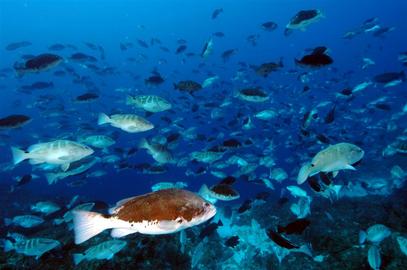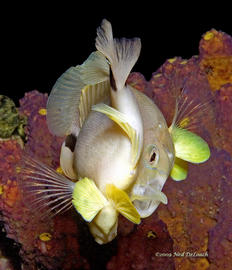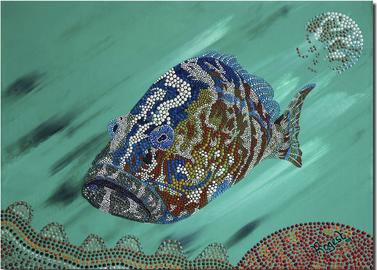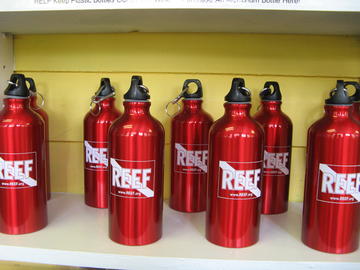Author: Brice Semmens, Ph.D., Grouper Moon Project Lead Scientist
Since 2001, REEF has led the Grouper Moon Project, a multi-faceted, collaborative research effort with the Cayman Islands Department of the Environment (CIDOE) aimed at better understanding Nassau grouper reproduction and the role that marine reserves can play in the long-term protection of this endangered species. Earlier this month, we had researchers and volunteers in the field for two weeks to conduct field research on spawning aggregations in Grand Cayman and Little Cayman. The site on Little Cayman represents one of the largest known remaining aggregations of Nassau grouper; our research will provide valuable guidance to both the Cayman Islands government and others throughout the Caribbean on how to best protect this important coral reef fish.
In 2003 the Cayman Island Marine Conservation Board instituted an 8-year fishing ban on Nassau grouper at all known aggregation sites in the Cayman Islands (both current and historic). This followed the discovery by fisherman of 7,000 aggregating Nassau grouper on the west end of Little Cayman in 2001 and the subsequent harvest of 4,000 of those fish over two spawning seasons. At the time, all other known Nassau grouper aggregations in the Cayman Islands had become inactive due to over-harvest. Thanks to a three-year grant awarded in 2008 by the Lenfest Ocean Program of the Pew Charitable Trusts, REEF is conducting research through the Grouper Moon Project to evaluate the current status of the Cayman Islands spawning aggregations and the effect of these harvest protections -- “The reproductive biology of remnant Nassau grouper stocks: implications for Cayman Islands Marine Protected Area (MPA) management”.
The broad goals for the 2010 spawning season were to continue monitoring recovery in the large spawning aggregation on Little Cayman, and to expand research into the fate of remnant spawning aggregations on Grand Cayman; aggregations on this island were fished to exhaustion in the recent past. REEF continued education and outreach efforts through public talks about spawning aggregations and the Grouper Moon research. As the sunset provision on the current legislation nears, REEF is working closely with the Cayman Islands government to translate the findings from our research into effective long-term protections. I spent time with the Honorable Mark Scotland, the Minister of Health, Environment, Youth, Sports & Culture, which oversees the Department of Environment in the Cayman Islands, discussing the project, our ground-breaking results, and recommendations for the future of this iconic species.
2010 Aggregation Season Results Summary
The Little Cayman team continued the long-term monitoring of this aggregation, which includes counting the number of fish that show up, estimating the size of the fish, and recording the timing and amount of spawning observed. The REEF research team uses lasers mounted on a video camera to record sizes of fish. If you would like to see what the Little Cayman aggregation looks like during the day, check out this video on YouTube. You will see the laser marks on the fish. Note that these are all Nassau grouper, just in different spawning colors. The team estimated that the number of fish showing up at the aggregation is approaching 4,000. We are also seeing a decrease if average size, which indicates that younger fish are starting to show up (good news!). Spawning was observed on four consecutive nights, starting 4 days after the full moon.
The Grand Cayman team’s primary goal was to document the remnant Nassau grouper aggregation on the East End of Grand Cayman and hopefully observe spawning. The status of this aggregation was initially documented by a Grouper Moon team in 2009. This year, with a lot of help from our partners at CIDOE and Wayne Sullivan and his crew aboard the Glen Ellen, REEF volunteer Denise Mizell was able to head up this critical component of our research. While several hundred fish were found at this historical spawning site, spawning was not documented. Unfortunately, we believe that fisherman were illegally fishing on the aggregation when our team was not on site. It is possible that this disturbance prevented the fish from spawning. This is disappointing news, but we are hopeful that the Cayman Islands government will pass revised legislation and provide more enforcement before next spawning season in order to protect the few remaining Nassau grouper on Grand Cayman.
Why Does This Matter?
Nassau grouper are not just icons of the Caribbean; they are a social and ecological cornerstone of the region’s coral reefs. Historically, Nassau grouper represented one of the region’s most economically important fisheries. Unfortunately, due to intense harvest on spawning aggregations, their populations have dwindled to a fraction of their historic numbers. The species became the first Caribbean reef fish to be listed as endangered by the International Union for the Conservation of Nature (IUCN) and the species is candidate listed under the US Endangered Species Act. The precipitous decline in mass spawning aggregations of Caribbean grouper species has been well documented. The majority of known Caribbean aggregation sites are now inactive due to the ease with which aggregating species are caught. And those that are still active contain significantly fewer fish than the 10s of thousands that historically gathered at these special places.
As part of our work on the Grouper Moon Project, REEF will continue to develop a comprehensive assessment of the status of the Cayman Island’s Nassau grouper spawning population as a guide for future Nassau grouper restoration and conservation policy.
Collaborators and Supporters Who Make This Project Possible
REEF would like to thank our collaborators at the Cayman Islands Department of the Environment, specifically Phil Bush, Bradley Johnson, Croy McCoy, James Gibb, Tim Austin, Gina Ebanks-Pietre, Keith Neale, Delwin McLaughlin and Robert Walton, as well as Drs. Scott and Selina Heppell from Oregon State University. REEF Volunteers have always been at the core of our Grouper Moon field work and 2010 was no exception – heartfelt thanks to Heather George, Steve Gittings, Denise Mizell and Sheryl Shea. The support and assistance of Thor Dunmire is also greatly appreciated. The Grouper Moon Project has continued through the years empowered by the first year’s success and the passion of early project leader Leslie Whaylen Clift. Assistance from OSU graduate student, Stephanie Kraft Archer, is much appreciated. Principal financial support is from the Lenfest Ocean Program of the Pew Charitable Trusts and the CIDOE. Additional funding is from Mr. Wayne Panton, Mr. Dan Scott, Clive and Stella Wood, Franklin and Cassandra Neal, and hundreds of REEF members. Continued in-kind logistical support from island businesses and residents, including the Little Cayman Beach Resort/Reef Divers, the Southern Cross Club, Peter Hillenbrand, Dottie Benjamin, and Judie Clee is also much appreciated. To alleviate the constraints of diving deep depths on regular scuba, several other sponsors came on board to assist in the project, including Divetech and PM Gas of Grand Cayman, Silent Diving of Brockville, Ontario and Shearwater Research of Vancouver, British Columbia.
And finally, our work on Grand Cayman would not have been possible without the generous support of Wayne Sullivan, who donated his vessel the Glen Ellen, his time (and patience), his equipment and technical diving expertise, and his crew, Brady Booton and several others.
For more information on the project, visit the Grouper Moon Project Webpage. If you would like to support this critical marine conservation research, please donate today through the REEF Website or call REEF HQ at 305-852-0030.
Author: Anna DeLoach, REEF Board of Trustees Member and Renowned Underwater Naturalist
The first time we ever saw Hamlets spawn, Ned and I were on a liveaboard REEF trip in Belize. We were just starting serious work on the behavior book at the time and still unaware of just how rewarding dusk dives can be for fish watchers. Trying to squeeze in a fourth dive before dark, our group dropped in just before sunset, agreeing to be back up in time for dinner.
These were the days when I could still add new fish to my life list on almost every dive trip and the charismatic Hamlets with their 11 distinct color morphs and various “hybrid” variations were especially prized sightings (we’ll save the species debate for another day). Hamlets are solitary hunters during the day. So when we saw two chasing each other about, we instinctively knew something out of the ordinary was happening. But, was it love or war?
The traditional color of one of the pair was noticeably blanched. We’d seen that happen with fighting Sailfin blennies - the fish that was out of its hole turns very pale. But the behavior of the Hamlets was more reminiscent of flirtation rather than conflict. The fish being pursued would race ahead then stop, usually with its nose pointed up, twitch, and immediately take off once again as soon as the pursuer caught up. For over twenty minutes they dashed about in all directions before always returning to the same coral head.
Finally, just as the last light was fading, the hamlets paused above the coral head only inches apart, entwined their 3-inch bodies and slowly rose together a foot or two. I know we aren’t supposed to anthropomorphize, but it certainly looked like love to us. Suddenly, they popped apart releasing a white puff of gametes and immediately darted back toward the reef. Instead of going their separate ways, the chasing, nuzzling and twitching began anew and shortly they spawned again, then again and again before they finally disappeared, going their separate ways into the night.
Later we learned to our amazement that Hamlets are simultaneous hermaphrodites, with each partner possessing both male and female reproductive organs. This unusual scenario, known as egg trading, allows each couple to play both the male and female role each evening. The fish assuming the role of the female plays the aggressor, twitching and chasing the blanched, interim male about. After each spawn the roles reverse until the lovers are finally spent.
The best news for fishwatchers is Hamlets appear to spawn each evening year-round. So, on your next dusk dive in the Tropical Western Atlantic make a point of watching for Hamlets; if you do you’re sure to be entertained.
Note: a short video of Spawning Hamlets is available on REEF’s YouTube Channel, WeSpeakFish: http://www.youtube.com/watch?v=lEMCqVBB0CM
Author: Heather George, REEF Board of Trustees
Want to add a few new species to your life list? Look no further than Dominica and Bonaire. These islands both offer some unique treasures and are sure to please every level of diver as well as beauty above water for your non-diving companions. REEF is leading Field Surveys to both of these beautiful islands this year, and we invite you to join us! The Dominica field survey trip is April 17 - 24, and Bonaire takes place September 25 – October 2.
The natural beauty of Dominica includes some of the most enchanting topography both above and below the waterline, with several waterfalls and hiking trails to be explored on one of the least developed islands in the Caribbean. The diving is also spectacular, and on our last trip here seven years ago flying gurnards, short-nose batfish, fringed filefish, blackfin snapper, harlequin pipefish and reef scorpionfish were all documented by our keen-eyed surveyors. REEF Board member Heather George is leading the trip this year, and she will help you look for these species and many more.
Few dive sites in the world can provide 100 fish species on a single dive - Bonaire is one of these special places. During our survey week here, you are likely to add at least 5 or more new species to your life list, no matter what your current REEF level. Trip Leader, Jessie Armacost, lived in Bonaire and taught Fish ID there for 7 years. She will help you find clingfish, pikeblennies, maculated flounders, medusa blennies, semi-scaled gobies and many other fish that are rarely found elsewhere. During group sessions you will learn where to look for viper morays, ringed blennies as well as popular fish like spotted drums and seahorses. The diving is easy with great accessible shore dives as well as easy close-by boat dives, and the trip will be particularly exciting this year during the annual coral spawn, when the reef is charged with sexual energy day and night.
Join us on one of these exciting weeks full of fish ID, friendship, new discoveries and great memories! Our full field survey schedule, trip details, and sign up information can be found here.
Author: Christy Pattengill-Semmens, REEF Director of Science
Last Summer, REEF friend and world famous painter, diver and character extraordinaire, Ron Steven (aka Rogest), created a brand new piece celebrating the Nassau grouper. Rogest was inspired after talking with REEF scientists about the REEF Grouper Moon Project and the important conservation research being done to study one of the last remaining spawning aggregations of the endangered Nassau grouper. Rogest painted "Grumpy", which features the face of a Nassau grouper, with the tag line "Extinction Makes Me Grumpy". He has since been inspired to create additional pieces with Grumpy. REEF members will have an exclusive opportunity to purchase one of these original paintings later this Spring and Rogest will be donating over half of the proceeds to the Grouper Moon Project. More information coming soon. We extend a big thank you to Rogest for his dedication and passion for REEF's marine conservation efforts. The artwork is also being featured on T-shirts available for sale in the REEF Gear Store.









